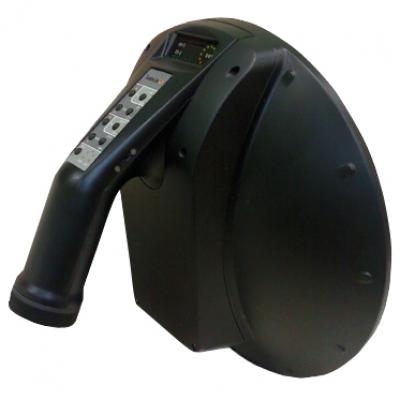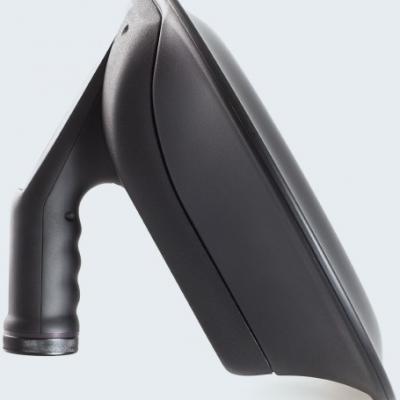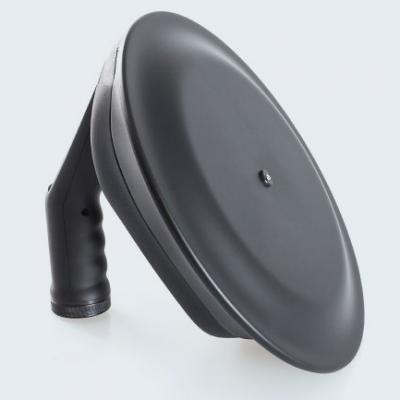Double Probing Frequency Non-Linear Junction Detector
LORNET-0836
The non-linear junction detector (NLJD) LORNET-0836 is designed to detect hidden electronic devices which contain semiconductors with p-n junctions such as covert audio and video transmitters, audio and video recorders, actuation and timer circuitry of improvised explosive devices (IED's). The NLJD can be used in TSCM and counter-terrorism applications in the field, in premises and in vehicles.
- LORNET-0836 is the world's only non-linear junction detector with DPF (double probing frequency) technology. The use of DPF with a patented antenna system design delivers a unique combination of the advantages inherent in a classic NLJD (790 MHz) and in a high-frequency NLJD (3600MHz).
- The 790 MHz probing signal provides effective detection in absorbing mediums such as concrete constructions or wet soil which would impair propagation of electromagnetic waves at higher frequencies.
- In the 790 MHz probing mode LORNET-0836 is not inferior to high power NLJD's in terms of detection but is significantly superior to them in terms of sanitary specifications. The average power in the target direction does not exceed 65 mW whereas the power towards the operator is additionally attenuated by at least 10dB thanks to the reduced rear lobe of the antenna.
- The 3.6 GHz probing mode provides unrivalled capabilities of detecting tiny semiconductor elements hidden by various materials (the detection occurs through small slots and apertures in the cover, ungrounded shielding as wells via smooth surface reflections).
- The 3.6 GHz antenna narrow directional pattern with laser pinpointing allows for high precision spatial selection of different semiconductors while working at a significant distance (up to 3-5 meters) from the target object which is an extremely important feature when it comes to identification of potentially explosive devices. It is very convenient for examining suspended ceilings since one doesn't have to use ladder all the time.
- The possibility to utilize two different antenna patterns (wide and narrow) in one NLJD dramatically increases the effectiveness of search works. The wide antenna pattern (790 MHz mode) allows the operator to quickly estimate the environment for potential threats whereas the narrow pattern (3.6 GHz mode) helps him to precisely locate the target object.
- The convenient control interface familiar to users from other LORNET models makes operation easy and straightforward.
- LORNET-0836 has been built with a breakthrough technology and innovative materials - the result is impressive performance as well as light weight and improved ergonomics.
An NLJD operation principle is based on illuminating a certain object under search with high power RF energy (either CW or pulsed) and on receiving the re-emitted object response at the multiples of the probing signal frequency (its second and third harmonics). The NLJD capability of detecting hidden electronics comes from the non-linear properties of semiconductors. Any electronic device will contain some printed circuit boards (PCB's) with conductors (virtual antennas) to which various semiconductor elements (diodes, transistors, microchips) are connected. For a high frequency probing signal all these elements can be considered as non-linear reflectors. This high frequency probing signal will induce in these conductors an alternating emf being converted by elements with a non-linear volt-ampere characteristic into RF signals on multiples (harmonics) of the probing frequency. These harmonics will be eventually re-emitted into space and detected by the NLJD's receivers tuned to these very frequencies. Detecting the 2-d and 3-rd harmonics of the probing signal by NLJD's receivers will mean that a hidden radioelectronic device is present in the illuminated area regardless of whether this device is powered on or switched off. It is conventionally assumed that the detected non-linear object is artificial in origin if the second harmonic's level exceeds that of the third one. If opposite is the case then the detected object is considered a natural non-linear junction of MOM-type (metal-oxide-metal). However, the NLJD application practice tells us that the mentioned criterion of the object origin identification may not always work well (e.g. a rusty metal element may exhibit a higher second harmonic level). In such a case additional identification methods may prove useful. This is where harmonics spectrum analysis will come really handy. In an ambiguous situation one may want to apply some physical impact on the object under search (e.g. knocking at it) while observing the second and third harmonics spectrum (or listening to the demodulated harmonics response in the headphones). The natural objects under a physical impact will show spectrum widening (regrowth) whereas the harmonics spectrum of artificial (electronic) object will remain largely unchanged. During demodulation the spectrum regrowth will manifest itself as a rustling noise in the headphones.
MAIN CHARACTERISTICS |
||||
|---|---|---|---|---|
| 790 MHz Frequency Range | 3600 MHz Frequency Range | |||
| Probing Signal Frequency | 789.5 MHz, 790.5 MHz, 791.5 MHz | 3581.5 MHz, 3594.5 MHz, 3607.5 MHz | ||
| The probing frequency is selected automatically when the device is powered on based on the criterion of minimal interference in the 2-d harmonic receive path. | ||||
| Transmitter Antenna Gain | 6 dB | 20 dB | ||
| Probing Signal Maximum Power (Peak/Average) | ||||
| Low Duty Cycle Pulse Mode | 18 W/64 mW (duty cycle 0,36%) | |||
| High Duty Cycle Pulse Mode | 6 W/375 mW (duty cycle 6,25%) | |||
| Probing Signal Power Adjustment Range | 20 dB (8 steps) | |||
| Receiver frequencies correspond to the 2-d (2xF) and 3-rd (3xF) harmonics of the probing signal | ||||
| Receivers Sensitivity | -110 dBm (measured in coaxial environment, without antennas, with a calibration signal applied from a test signal generator directly to the receiver input) | |||
| Receive Path Dynamic Range | 24 dB | |||
| Operation Time from the built-in accumulator at the maximum rated power | 2,5 hours in the low duty cycle pulse mode; 1,5 hours in the high duty cycle pulse mode | |||
| NLJD Dimensions, cm | 31х31х28 | |||
| NLJD Weight in the operating mode | 1,45 kg | |||
| Carrying Bag Dimensions, cm | 45х30х35 | |||
| NLJD Weight in the carrying bag | 4,5 kg | |||
| Operation Temperature Range | +5...+40°С | |||
ORDERING INFORMATION |
||||
|---|---|---|---|---|
| LORNET-0836 | Double Probing Frequency NLJD | US$ 13,500 | ||
| The delivery set includes: NLJD LORNET-0836, two replaceable LI-ION batteries, a 220V battery charger, a battery charging container, wireless headphones with receiver, a 220V receiver adapter, NLJD carrying bag and operation manual. | ||||






